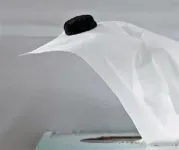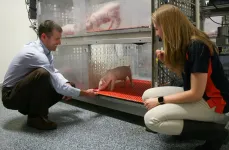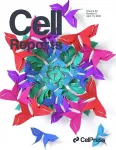Finally, 3D-printed graphene aerogels for water treatment
Study shows how to make stable and large aerogels that remove heavy metals, organic solvents, organic dyes
2021-04-14
(Press-News.org) BUFFALO, N.Y. -- Graphene excels at removing contaminants from water, but it's not yet a commercially viable use of the wonder material.
That could be changing.
In a recent study, University at Buffalo engineers report a new process of 3D printing graphene aerogels that they say overcomes two key hurdles -- scalability and creating a version of the material that's stable enough for repeated use -- for water treatment.
"The goal is to safely remove contaminants from water without releasing any problematic chemical residue," says study co-author Nirupam Aich, PhD, assistant professor of environmental engineering at the UB School of Engineering and Applied Sciences. "The aerogels we've created hold their structure when put in water treatment systems, and they can be applied in diverse water treatment applications."
The study -- "3D printed graphene-biopolymer aerogels for water contaminant removal: a proof of concept" -- was published in the Emerging Investigator Series of the journal Environmental Science: Nano. Arvid Masud, PhD, a former student in Aich's lab, is the lead author; Chi Zhou, PhD, associate professor of industrial and systems engineering at UB, is a co-author.
An aerogel is a light, highly porous solid formed by replacement of liquid in a gel with a gas so that the resulting solid is the same size as the original. They are similar in structural configuration to Styrofoam: very porous and lightweight, yet strong and resilient.
Graphene is a nanomaterial formed by elemental carbon and is composed of a single flat sheet of carbon atoms arranged in a repeating hexagonal lattice.
To create the right consistency of the graphene-based ink, the researchers looked to nature. They added to it two bio-inspired polymers -- polydopamine (a synthetic material, often referred to as PDA, that is similar to the adhesive secretions of mussels), and bovine serum albumin (a protein derived from cows).
In tests, the reconfigured aerogel removed certain heavy metals, such as lead and chromium, that plague drinking water systems nationwide. It also removed organic dyes, such as cationic methylene blue and anionic Evans blue, as well as organic solvents like hexane, heptane and toluene.
To demonstrate the aerogel's reuse potential, the researchers ran organic solvents through it 10 times. Each time, it removed 100% of the solvents. The researchers also reported the aerogel's ability to capture methylene blue decreased by 2-20% after the third cycle.
The aerogels can also be scaled up in size, Aich says, because unlike nanosheets, aerogels can be printed in larger sizes. This eliminates a previous problem inherent in large-scale production, and makes the process available for use in large facilities, such as in wastewater treatment plants, he says. He adds the aerogels can be removed from water and reused in other locations, and that they don't leave any kind of residue in the water.
Aich is part of a collaboration between UB and the University of Pittsburgh, led by UB chemistry professor Diana Aga, PhD, to find methods and tools to degrade per- and polyfluoroalkyl substances (PFAS), toxic materials so difficult to break down that they are known as "forever chemicals." Aich notes the similarities to his work with 3D aerogels, and he hopes results from the two projects can be brought together to create more effective methods of removing waterborne contaminants.
"We can use these aerogels not only to contain graphene particles but also nanometal particles which can act as catalysts," Aich says. "The future goal is to have nanometal particles embedded in the walls and the surface of these aerogels and they would be able to degrade or destroy not only biological contaminants, but also chemical contaminants."
Aich, Chi, and Masud hold a pending patent for the graphene aerogel described in the study, and they are looking for industrial partners to commercialize this process.
INFORMATION:
[Attachments] See images for this press release:

ELSE PRESS RELEASES FROM THIS DATE:
2021-04-14
HERSHEY, Pa. -- People who trust television and Facebook to provide them with accurate news about the coronavirus pandemic are less knowledgeable about COVID-19, according to a new study, which assessed people's knowledge of the virus in the earliest stages of the pandemic.
The study, published in the peer-reviewed journal Current Medical Research & Opinion, surveyed 5,948 adults in Pennsylvania between March 25-31, 2020, and found that those who relied on social media and TV for news were less likely to get the facts right about the coronavirus.
In fact, adults that used Facebook as an additional ...
2021-04-14
URBANA, Ill. - Before humans can benefit from new drug therapies and nutritional additives, scientists test their safety and efficacy in animals, typically mice and rats. But, as much as they've done for biomedical research, rodents aren't always the best research model for studies on neonatal brain development and nutrition. That's where pigs can play an important role.
University of Illinois researchers say the domestic pig is ideal for these studies because their brain size, rate of development, and digestive system are excellent analogues for human newborns.
They know a lot about pig brains, having built the first - and recently, the second - complete, MRI-based atlases of the organ. They've used the first to study ...
2021-04-14
La Jolla, CA--The human genome contains the instructions to make tens of thousands of proteins. Each protein folds into a precise shape--and biologists are taught that defined shape dictates the protein's destined function. Tens of thousands of singular shapes drive the tens of thousands of needed functions.
In a new Cell Reports study, researchers at La Jolla Institute for Immunology demonstrate how Ebola virus has found a different way to get things done. The virus encodes only eight proteins but requires dozens of functions in its lifecycle. ...
2021-04-14
New research by a team at Resources for the Future (RFF) has found that at least 27% of new pests in the United States were initially detected by members of the general public. The study, which was published today in the journal Conservation Science and Practice, seeks to understand who is identifying new invasive species that make their way into the United States.
The RFF team developed and analyzed a new dataset of pest discoveries in the United States, using a sample size of 169 detections from 2010 to 2018. Researchers divided discovery sources into three categories: government agencies, local extension specialists and researchers, and members of the public, with the latter category including community ...
2021-04-14
ITHACA, N.Y. - Just as humans are challenged from the social isolation caused by the coronavirus pandemic, a new study finds that a solitary lifestyle has profound effects on the brains of a social insect: paper wasps.
Paper wasps recognize the brightly colored faces of other paper wasps, an ability they lose when reared in isolation. The wasps' ability to remember faces is similar to primates and humans, but unlike other social insects.
The study revealed that when adult wasps are housed in solitude, visual areas of their brains - especially those involved with identifying nuanced color patterns and shapes - are smaller and less developed ...
2021-04-14
Researchers from the HSE Center for Language and Brain https://www.hse.ru/en/neuroling/ have, for the first time, described the language abilities of Russian children with Autism Spectrum Disorder (ASD) at all linguistic levels (e.g., phonology, lexicon, morphosyntax, and discourse), using a language test that takes into account the psycholinguistic variables most relevant for Russians. The study was published in Journal of Autism and Developmental Disorders.
In 2020, the US Centers for Disease Control and Prevention reported that one in every 54 children in the country is diagnosed with ASD. Usually, ...
2021-04-14
Ultralight bosons are hypothetical particles whose mass is predicted to be less than a billionth the mass of an electron. They interact relatively little with their surroundings and have thus far eluded searches to confirm their existence. If they exist, ultralight bosons such as axions would likely be a form of dark matter, the mysterious, invisible stuff that makes up 85 percent of the matter in the universe.
Now, physicists at MIT's LIGO Laboratory have searched for ultralight bosons using black holes -- objects that are mind-bending orders of magnitude ...
2021-04-14
Little is known about azhdarchid pterosaurs, gigantic flying reptiles with impressive wingspans of up to 12 meters. Cousins of dinosaurs and the largest animals ever to fly, they first appeared in the fossil record in the Late Triassic about 225 million years ago and disappeared again at the end of the Cretaceous period about 66 million years ago. One of their most notable features for such a large flighted animal was a neck longer than that of a giraffe. Now, researchers report an unexpected discovery in the journal iScience on April 14: their thin neck vertebrae got their strength from an intricate internal structure unlike anything ...
2021-04-14
Describing the genetic diversity of human populations is essential to improve our understanding of human diseases and their geographical distribution. However, the vast majority of genetic studies have been focused on populations of European ancestry, which represent only 16% of the global population. Scientists at the Institut Pasteur, Collège de France, and CNRS have looked at understudied human populations from the South Pacific, which are severely affected by a variety of diseases, including vector-borne infectious diseases such as Zika virus, dengue, and chikungunya, and metabolic diseases such as obesity and diabetes. Using genome sequencing of ...
2021-04-14
In physics, things exist in "phases", such as solid, liquid, gas. When something crosses from one phase to another, we talk about a "phase transition" - think about water boiling into steam, turning from liquid to gas.
In our kitchens water boils at 100oC, and its density changes dramatically, making a discontinuous jump from liquid to gas. However, if we turn up the pressure, the boiling point of water also increases, until a pressure of 221 atmospheres where it boils at 374oC. Here, something strange happens: the liquid and gas merge into a single phase. Above this ...
LAST 30 PRESS RELEASES:
[Press-News.org] Finally, 3D-printed graphene aerogels for water treatment
Study shows how to make stable and large aerogels that remove heavy metals, organic solvents, organic dyes



